
Wayfinding signs are popping up around downtown.

Wayfinding signs are popping up around downtown.
“Beginning this weekend, wayfinding signs will be installed in Downtown Raleigh.
The signs will help direct visitors to downtown from Raleigh’s major entryways and direct them to locations within downtown, such as parking areas and attractions. Signs for both pedestrians and motorists will be used.”
– Raleigh Installing Wayfinding Signs Downtown – Wake County – MyNC.com
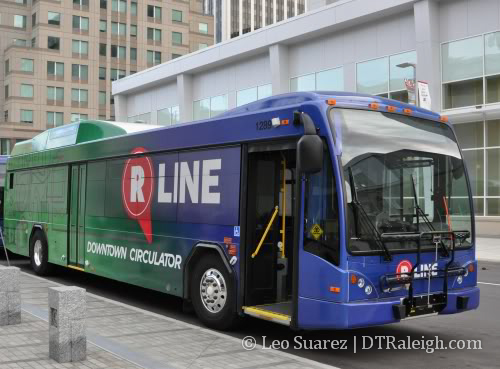
A month ago the R-Line started making its rounds in downtown. Today, yet another Friday the 13th, is time to look at the past month and discuss the new downtown service. RalCon’s page to rep the R-Line is here or through the link at the top.
Ridership
I have no hard numbers to show but from what I have seen and heard, the ridership is busier during the most obvious of hours. Lunch during the weekday and Friday/Saturday nightlife hours are the most popular times to see groups of people on the R-Line. I’m rarely in downtown during the lunch hours so I’ll trust the few people who have told me this, including one of the bus drivers. There were about 10-14 people riding on the few Friday and Saturday nights that I have been on. I’m not sure what the city expects but these seem like solid numbers in its first month of service. As with anything, it will take some time for people to absorb the R-Line and incorporate it into their routine. As for visitors and convention center mobs, they are steered toward using the R-Line with the Downtown Raleigh Alliance’s new marketing campaign, You R Here, which is a great looking website and I applaud them for re-designing the site.
Convenience
The R-Line is pretty convenient and it makes downtown seem a little smaller. Fayetteville St. and Glenwood South are now a short ride away. However, it is a game to see how long you will wait at a stop for a bus. I have not seen any times posted so I’m guessing the bus is not on a set schedule. There have been times when I have caught the R-Line the minute I walked up to a stop. Other times, I have seen it pull away as I turn the corner resulting in a ‘long’ wait. The 10-15 minute wait time has been accurate though and in my experience, I’ve rarely waited more then 15 minutes. While not necessary right now, a website similar to TranLoc could be created to show people the bus’s current location. A mobile version of this website would be even more powerful, especially now that the city is flirting with the idea of bringing free wifi all over downtown. Its just an idea but not needed right now as the bus is pretty convenient overall.
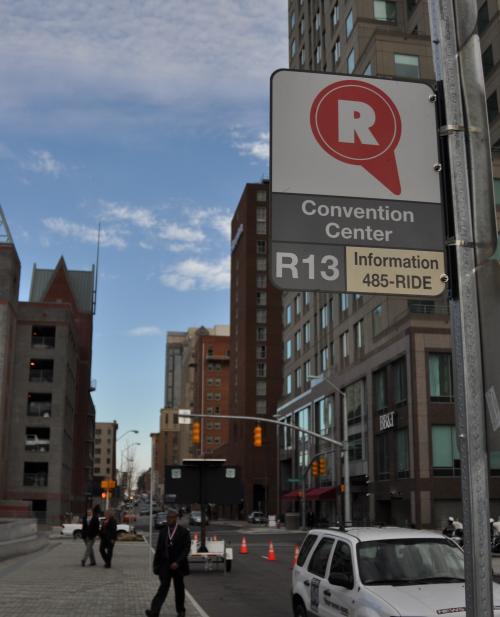
Signage
The R-Line stop signage may need a little upgrade. On a positive note, the signs are large and clear with the stop name and number at each location. The problem with the signs is that a casual pedestrian that does not know of the R-Line is not well informed. There is a number to call but I think it would be much more informative if a map and route were shown on the signs. Also, the extended route after 6:30pm needs to be highlighted so people are not confused by the change in route.
Hybrid Buses
Have you seen the buses? They stand out pretty well in the middle of traffic and draw attention to themselves. This should self promote the R-Line and get people talking. Also, the hybrid buses are noticeably quieter then the CAT buses coming out of Moore Square. Another thing I’ve noticed is that the buses sometimes look too big and making turns can be a little tight at times. In some instances, I’ve seen cars backing up to let it pass. This might take a slight tweaking of the lines on the street so that the R-Line can flow more smoothly.
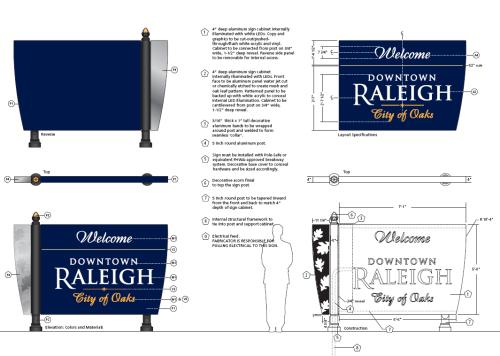
If you have been lurking around Hargett or Wilmington St. recently, you may have noticed some holes in the sidewalks. I’ve started to notice more and more of these wood covered holes at the intersection of Fayetteville and Hargett, Wilmington St. near the museums, and near the Moore Square parking deck. At first I thought these were the parking meters that we have discussed before but that would be too quick a move on the city’s part. It finally hit me though and these holes have to be the locations for the new downtown signage that will go up soon.
The signage was approved last year and the city’s website has all the info. Looking at the pdf files confirms that these holes will have new signs to help people get around downtown Raleigh. Here are some key links for those that want more info.
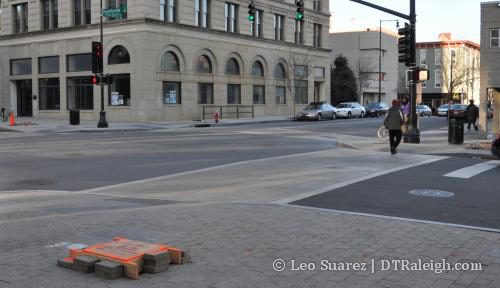
Three holes at Fayetteville/Hargett St.

On Hargett St. across from the bus station.
This Thursday, March 5 at 6:30-7:30 pm, there will be a public meeting showing the Capital Area Metropolitan Planning Organization’s transit proposal through 2035. The meeting is at city hall, which is at 222 W. Hargett St. for the clueless.
Click here to view the entire CAMPO plan (pdf) or visit CAMPO’s website.
To sum up the plan, the proposal will involve:
For those freaking out over the snow in the area, remember that light rail can still get you around if Raleigh reaches gridlock status.
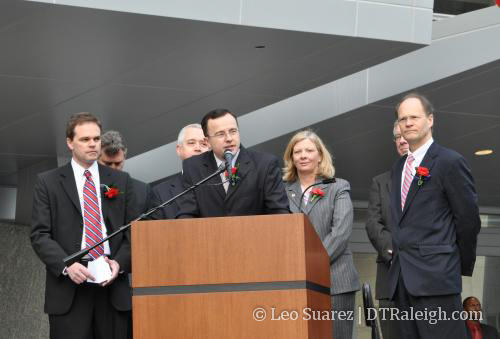
This morning, Mayor Meeker and his downtown buddies introduced the R Line, downtown’s new circulator. We have recently talked about this and today is the day that the hybrid electric buses start rolling. Buses stop every 10 to 15 minutes and run during the following hours every week:
Mon-Wed: 7am – 11pm
Thurs-Sat: 7am – 2:15am
Sun: 1pm – 8pm
This week I found out that there will be a route extension after 6:30 pm. Take a look at the google map embedded here and you will see what I mean (shown in red).
View Larger Map
I’m working on a dedicated page for all info that is the R Line. Along with the google map, I have also made a printable map of the route and a few key stops. I’m working on that one too and am trying to make it match the excellent map on the Downtown Raleigh Alliance website. How will you use the R Line?

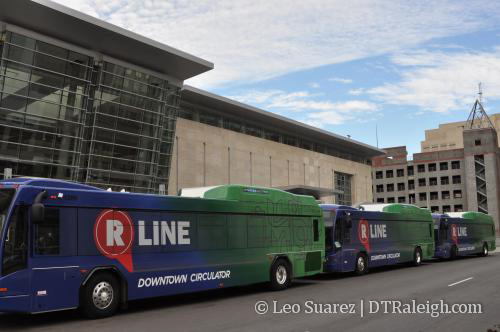
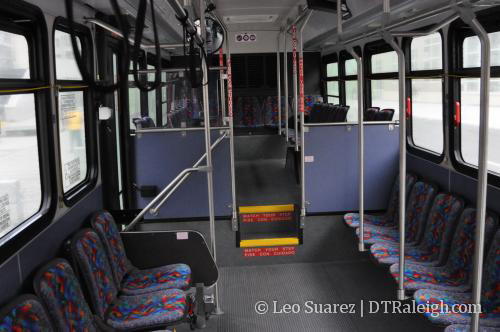
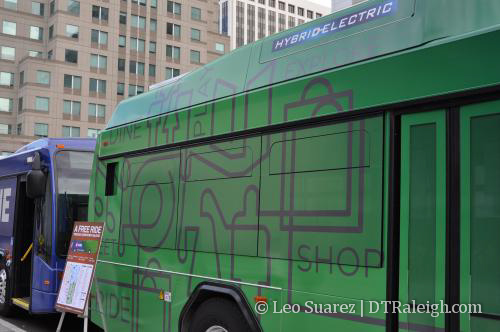

A great addition is possibly coming to downtown next month. The city is proposing a free downtown circulator (finally!) and has more details on their website here, with a .pdf map of the route here.
Let’s geek out a little and break down the route to see how much nicer travel within downtown will be. This is what we know or will assume:
Unless you are speeding, no one can drive that entire route under the speed limit in 10 minutes. I know this because I tried it. (disclaimer: Yes, I do have a life. It just so happened that I needed to move my car and I got curious so I decided to drive the route and time it) Driving the route at a normal speed with little traffic takes just under 15 minutes. Add stop time for passengers and we are looking at a 20 minute total route time with one bus; if traffic is bad, who knows. So the wait time may suck but running two buses at peak hours will take care of that problem easily.
Travel time is hands down more convenient. Assuming a 20 minute round trip time, let’s assume that it takes 10 minutes to get to the midway point in the route. For example, if you are at the Performing Arts Center you can get to Glenwood South in about 10 minutes. The alternative is a 20 minute walk, $5 cab ride, or the guilt of punishing one unlucky rickshaw driver. With the circulator, you can sit down, pay nothing, and are out of the rain/cold/whatever.
The actual route looks very simple and touches on each downtown area. The downtown core is serviced through Wilmington St. with a stop at each block. This is very convenient for each block and the parking decks along the corridor. The route going straight down Glenwood South will probably be slowed by nightlife crowds but this is only a few hours of the week so it should not be changed. I think a stop at Davie and Dawson would make more sense then the stop at Cabarrus and Dawson because there are more businesses on Davie then Cabarrus. It is only one block however so no one should complain. The convention center is serviced beautifully with a stop right at the front door. This will also be extremely convenient for those staying at the Sheraton and the Marriott.
This simple loop should work out very well. Think of it like this; anyone is at least three blocks from a stop at anytime. That is a huge jump in convenience for anyone lurking around downtown. Also, the fact that the city wants to run hybrid buses is another bonus. Every hotel lobby, building lobby, and museum should have route maps to inform people of its existence.
Two thumbs up!
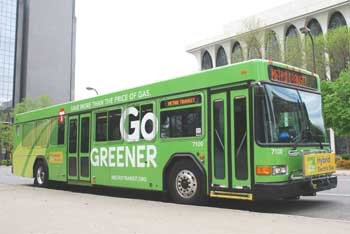
Green buses [UPDATE: 8:31am] This is what the buses could look like, not the actual buses that will be used.
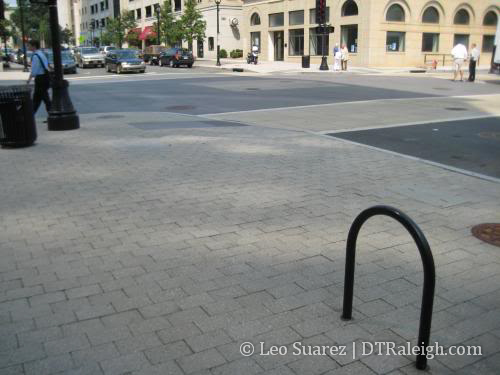
As a new bicycle owner, I’m starting to think about how bike-friendly downtown is. It is rather easy riding around on the streets within the core of downtown because of the naturally slower traffic and short distances. The issue I see, however, is the extreme lack of bike racks in the area and you can see it as riders chain their bikes to different poles and trees. Bike racks are also hard to find because there are simply too few of them. This will have to change so that the culture of commuting by bicycle to downtown grows.
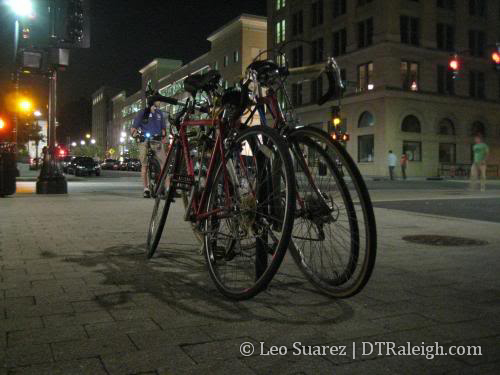
Bikes grouped together on Fayetteville St.
To maintain the quality and competitiveness of our downtown, I think that an alternative to driving should be offered. While mass transit is being figured out now, we can focus on ways to encourage people to get out of there cars and ride a bike, scooter, or other “one-person vehicle” to get in and out of downtown. Right now, I think that riding a bike to visit one day on the weekend and chaining it to a tree is kind of acceptable, because of the so few times that you actually do this. But to get the downtown employees to ride to work five days a week, we do not need more trees rather a bike “parking deck”. Just like anyone can drive downtown and leave their car in a deck, a bike should be parked in a small area that is specifically used for the purpose of storing your bike, scooter, hoverboard, whatever. Would you ride more if there were dedicated bike parking areas with:
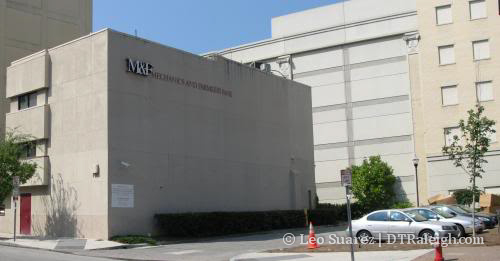
To incorporate the thoughts above, here is an idea that came about in a recent conversation with a friend on this topic. The picture above shows the M&F Bank parking lot on the corner of Hargett and Wilmington St. The lot is for employees only and has six spaces. I have nothing against the bank but I feel that this space should be given up and a deal cut for parking in the Alexander Square deck right behind them. This would be a perfect area for what I’m calling a Downtown Bike Pad.
The entire lot will be used for parking bikes, scooters, segways, and other “vehicles”. The pad will be flush with the street so the sidewalk “peninsula” will have to be flattened. This will make getting in and out by anyone pretty easy. The pad will also be a different color then the road, making it distinct and easy to find. Shelters can cover the area so that anyone’s “vehicle” is protected by any precipitation. Add an artistic touch to the whole thing and I think we’ll have something people will ride too. A LOT of people are already used to the idea of driving downtown, parking in a deck, then walking to their workplace. This is essentially the same thing but takes up less space, is more environmentally friendly, healthier for you, and a cheaper solution to building/expanding our parking deck arsenal.
My idea for the M&F Bank lot would be the ideal solution but until mass transit comes around 15-20 years from now, a modified version of this, perhaps on a smaller scale, could be used. If bike pads were strategically placed in a few spots downtown, I think we would see a rise in biking/alternative commuting and would be a great selling point for new residents and businesses looking at moving here.
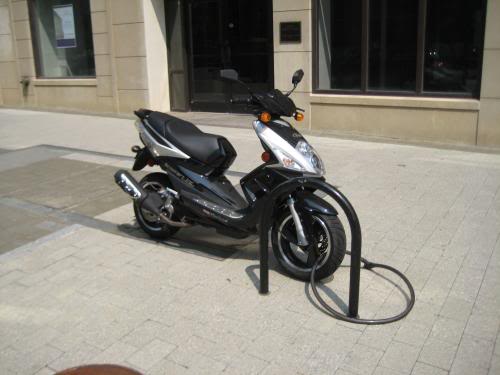
Bicycles are not the only ones parking in downtown
[UPDATE 10-6-08]
An update almost a month later but it is still relevant to the conversation. There is a bike rack in the municipal deck, facing Dawson St. at Morgan St. It will cover your bike or scooter from the weather and it is easy to get too. We need much more of these around downtown.
